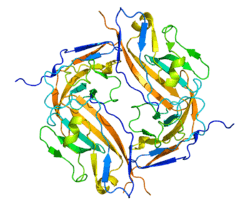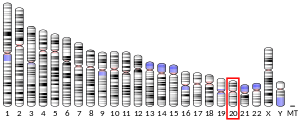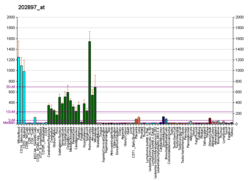Signal-regulatory protein alpha
Signal regulatory protein α (SIRPα) is a regulatory membrane glycoprotein from SIRP family expressed mainly by myeloid cells and also by stem cells or neurons.
SIRPα acts as inhibitory receptor and interacts with a broadly expressed transmembrane protein CD47 also called the "don´t eat me" signal. This interaction negatively controls effector function of innate immune cells such as host cell phagocytosis. SIRPα diffuses laterally on the macrophage membrane and accumulates at a phagocytic synapse to bind CD47 and signal 'self', which inhibits the cytoskeleton-intensive process of phagocytosis by the macrophage.[5] This is analogous to the self signals provided by MHC class I molecules to NK cells via Ig-like or Ly49 receptors.[6][7] NB. Protein shown to the right is CD47 not SIRP α.
Structure
The cytoplasmic region of SIRPα is highly conserved between rats, mice and humans. Cytoplasmic region contains a number of tyrosine residues, which likely act as ITIMs. Upon CD47 ligation, SIRPα is phosphorylated and recruits phosphatases like SHP1 and SHP2.[8] The extracellular region contains three Immunoglobulin superfamily domains – single V-set and two C1-set IgSF domains. SIRP β and γ have the similar extracellular structure but different cytoplasmic regions giving contrasting types of signals. SIRP α polymorphisms are found in ligand-binding IgSF V-set domain but it does not affect ligand binding. One idea is that the polymorphism is important to protect the receptor of pathogens binding.[6][9]
Ligands
SIRPα recognizes CD47, an anti-phagocytic signal that distinguishes live cells from dying cells. CD47 has a single Ig-like extracellular domain and five membrane spanning regions. The interaction between SIRPα and CD47 can be modified by endocytosis or cleavage of the receptor, or interaction with surfactant proteins. Surfactant protein A and D are soluble ligands, highly expressed in the lungs, that bind to the same region of SIRPα as CD47 and can therefore competitively block binding.[9][10]
Signalling
The extracellular domain of SIRP α binds to CD47 and transmits intracellular signals through its cytoplasmic domain. CD47-binding is mediated through the NH2-terminal V-like domain of SIRP α. The cytoplasmic region contains four ITIMs that become phosphorylated after binding of ligand. The phosphorylation mediates activation of tyrosine kinase SHP2. SIRP α has been shown to bind also phosphatase SHP1, adaptor protein SCAP2 and FYN-binding protein. Recruitment of SHP phosphatases to the membrane leads to the inhibition of myosin accumulation at the cell surface and results in the inhibition of phagocytosis.[9][10]
Cancer
Cancer cells highly expressed CD47 that activate SIRP α and inhibit macrophage-mediated destruction. In one study, they engineered high-affinity variants of SIRP α that antagonized CD47 on cancer cells and caused increase phagocytosis of cancer cells.[11] Another study (in mice) found anti-SIRPα antibodies helped macrophages to reduce cancer growth and metastasis, alone and in synergy with other cancer treatments.[12][13]
References
- GRCh38: Ensembl release 89: ENSG00000198053 - Ensembl, May 2017
- GRCm38: Ensembl release 89: ENSMUSG00000037902 - Ensembl, May 2017
- "Human PubMed Reference:". National Center for Biotechnology Information, U.S. National Library of Medicine.
- "Mouse PubMed Reference:". National Center for Biotechnology Information, U.S. National Library of Medicine.
- Tsai RK, Discher DE (2008). "Inhibition of "self" engulfment through deactivation of myosin-II at the phagocytic synapse between human cells". J Cell Biol. 180 (5): 988–1003. doi:10.1083/jcb.200708043. PMC 2265407. PMID 18332220.
- Barclay AN (2009). "Signal regulatory protein alpha (SIRPalpha)/CD47 interaction and function". Curr Opin Immunol. 21 (1): 47–52. doi:10.1016/j.coi.2009.01.008. PMC 3128989. PMID 19223164.
- Stefanidakis M, Newton G, Lee WY, Parkos CA, Luscinskas FW (2008). "Endothelial CD47 interaction with SIRPgamma is required for human T-cell transendothelial migration under shear flow conditions in vitro". Blood. 112 (4): 1280–9. doi:10.1182/blood-2008-01-134429. PMC 2515120. PMID 18524990.
- Okazawa, Hideki; Motegi, Sei-ichiro; Ohyama, Naoko; Ohnishi, Hiroshi; Tomizawa, Takeshi; Kaneko, Yoriaki; Oldenborg, Per-Arne; Ishikawa, Osamu; Matozaki, Takashi (2005-02-15). "Negative regulation of phagocytosis in macrophages by the CD47-SHPS-1 system". Journal of Immunology. 174 (4): 2004–2011. doi:10.4049/jimmunol.174.4.2004. ISSN 0022-1767. PMID 15699129.
- Barclay AN, Brown MH (2006). "The SIRP family of receptors and immune regulation". Nat Rev Immunol. 6 (6): 457–64. doi:10.1038/nri1859. PMID 16691243.
- van Beek EM, Cochrane F, Barclay AN, van den Berg TK (2005). "Signal regulatory proteins in the immune system". J Immunol. 175 (12): 7781–7. doi:10.4049/jimmunol.175.12.7781. PMID 16339510.
- Weiskopf K, Ring AM, Ho CC, Volkmer JP, Levin AM, Volkmer AK, et al. (2013). "Engineered SIRPα variants as immunotherapeutic adjuvants to anticancer antibodies". Science. 341 (6141): 88–91. Bibcode:2013Sci...341...88W. doi:10.1126/science.1238856. PMC 3810306. PMID 23722425.
- Potential new cancer treatment activates cancer-engulfing cells. Feb 2017
- Yanagita T (2017). "Anti-SIRPα antibodies as a potential new tool for cancer immunotherapy". JCI Insight. 2 (1): e89140. doi:10.1172/jci.insight.89140. PMC 5214103. PMID 28097229.
Further reading
- Oldenborg PA (2013). "CD47: A Cell Surface Glycoprotein Which Regulates Multiple Functions of Hematopoietic Cells in Health and Disease". ISRN Hematol. 2013: 614619. doi:10.1155/2013/614619. PMC 3564380. PMID 23401787.
- Yamauchi T, Takenaka K, Urata S, et al. (2013). "& Akashi, K. (2013). Polymorphic Sirpa is the genetic determinant for NOD-based mouse lines to achieve efficient human cell engraftment". Blood. 121 (8): 1316–1325. doi:10.1182/blood-2012-06-440354. PMID 23293079.
- Oldenborg PA (2004). "Role of CD47 in erythroid cells and in autoimmunity". Leuk. Lymphoma. 45 (7): 1319–27. doi:10.1080/1042819042000201989. PMID 15359629.
- Margolis RL, Breschel TS, Li SH, et al. (1996). "Characterization of cDNA clones containing CCA trinucleotide repeats derived from human brain". Somat. Cell Mol. Genet. 21 (4): 279–84. doi:10.1007/BF02255782. PMID 8525433.
- Ohnishi H, Kubota M, Ohtake A, et al. (1996). "Activation of protein-tyrosine phosphatase SH-PTP2 by a tyrosine-based activation motif of a novel brain molecule". J. Biol. Chem. 271 (41): 25569–74. doi:10.1074/jbc.271.41.25569. PMID 8810330.
- Fujioka Y, Matozaki T, Noguchi T, et al. (1997). "A novel membrane glycoprotein, SHPS-1, that binds the SH2-domain-containing protein tyrosine phosphatase SHP-2 in response to mitogens and cell adhesion". Mol. Cell. Biol. 16 (12): 6887–99. doi:10.1128/MCB.16.12.6887. PMC 231692. PMID 8943344.
- Sano S, Ohnishi H, Omori A, et al. (1997). "BIT, an immune antigen receptor-like molecule in the brain". FEBS Lett. 411 (2–3): 327–34. doi:10.1016/S0014-5793(97)00724-2. PMID 9271230.
- Brooke GP, Parsons KR, Howard CJ (1998). "Cloning of two members of the SIRP alpha family of protein tyrosine phosphatase binding proteins in cattle that are expressed on monocytes and a subpopulation of dendritic cells and which mediate binding to CD4 T cells". Eur. J. Immunol. 28 (1): 1–11. doi:10.1002/(SICI)1521-4141(199801)28:01<1::AID-IMMU1>3.0.CO;2-V. PMID 9485180.
- Timms JF, Carlberg K, Gu H, et al. (1998). "Identification of major binding proteins and substrates for the SH2-containing protein tyrosine phosphatase SHP-1 in macrophages". Mol. Cell. Biol. 18 (7): 3838–50. doi:10.1128/mcb.18.7.3838. PMC 108968. PMID 9632768.
- Veillette A, Thibaudeau E, Latour S (1998). "High expression of inhibitory receptor SHPS-1 and its association with protein-tyrosine phosphatase SHP-1 in macrophages". J. Biol. Chem. 273 (35): 22719–28. doi:10.1074/jbc.273.35.22719. PMID 9712903.
- Jiang P, Lagenaur CF, Narayanan V (1999). "Integrin-associated protein is a ligand for the P84 neural adhesion molecule". J. Biol. Chem. 274 (2): 559–62. doi:10.1074/jbc.274.2.559. PMID 9872987.
- Ohnishi H, Yamada M, Kubota M, et al. (1999). "Tyrosine phosphorylation and association of BIT with SHP-2 induced by neurotrophins". J. Neurochem. 72 (4): 1402–8. doi:10.1046/j.1471-4159.1999.721402.x. PMID 10098842.
- Timms JF, Swanson KD, Marie-Cardine A, et al. (1999). "SHPS-1 is a scaffold for assembling distinct adhesion-regulated multi-protein complexes in macrophages". Curr. Biol. 9 (16): 927–30. doi:10.1016/S0960-9822(99)80401-1. PMID 10469599.
- Seiffert M, Cant C, Chen Z, et al. (1999). "Human signal-regulatory protein is expressed on normal, but not on subsets of leukemic myeloid cells and mediates cellular adhesion involving its counterreceptor CD47". Blood. 94 (11): 3633–43. doi:10.1182/blood.V94.11.3633. PMID 10572074.
- Sano S, Ohnishi H, Kubota M (2000). "Gene structure of mouse BIT/SHPS-1". Biochem. J. 344 (3): 667–75. doi:10.1042/0264-6021:3440667. PMC 1220688. PMID 10585853.
- Yang J, Cheng Z, Niu T, et al. (2000). "Structural basis for substrate specificity of protein-tyrosine phosphatase SHP-1". J. Biol. Chem. 275 (6): 4066–71. doi:10.1074/jbc.275.6.4066. PMID 10660565.
- Stofega MR, Argetsinger LS, Wang H, et al. (2000). "Negative regulation of growth hormone receptor/JAK2 signaling by signal regulatory protein alpha". J. Biol. Chem. 275 (36): 28222–9. doi:10.1074/jbc.M004238200. PMID 10842184.
- Wu CJ, Chen Z, Ullrich A, et al. (2000). "Inhibition of EGFR-mediated phosphoinositide-3-OH kinase (PI3-K) signaling and glioblastoma phenotype by signal-regulatory proteins (SIRPs)". Oncogene. 19 (35): 3999–4010. doi:10.1038/sj.onc.1203748. PMID 10962556.
- Latour S, Tanaka H, Demeure C, et al. (2001). "Bidirectional negative regulation of human T and dendritic cells by CD47 and its cognate receptor signal-regulator protein-alpha: down-regulation of IL-12 responsiveness and inhibition of dendritic cell activation". J. Immunol. 167 (5): 2547–54. doi:10.4049/jimmunol.167.5.2547. PMID 11509594.
- Deloukas P, Matthews LH, Ashurst J, et al. (2002). "The DNA sequence and comparative analysis of human chromosome 20". Nature. 414 (6866): 865–71. Bibcode:2001Natur.414..865D. doi:10.1038/414865a. PMID 11780052.
This article incorporates text from the United States National Library of Medicine, which is in the public domain.







